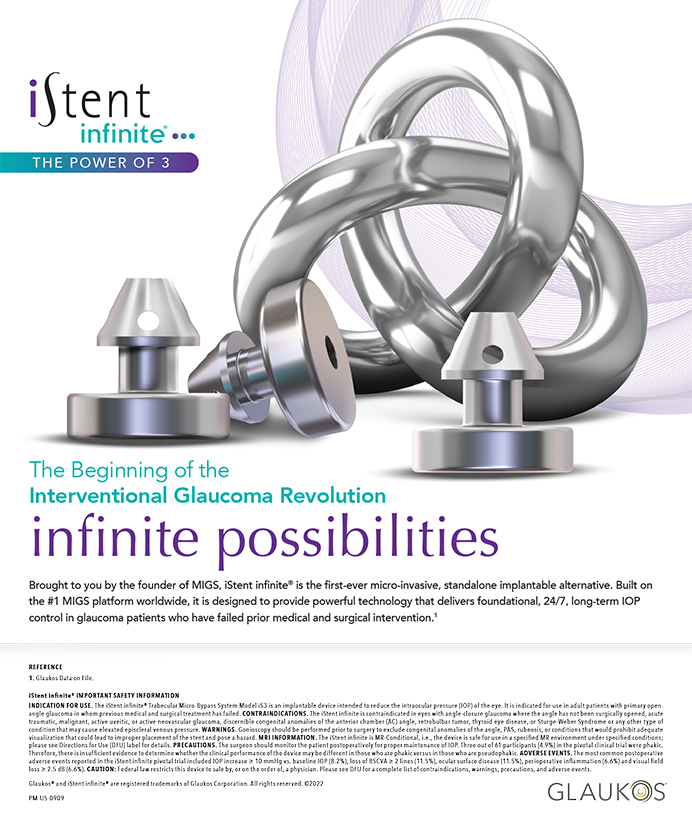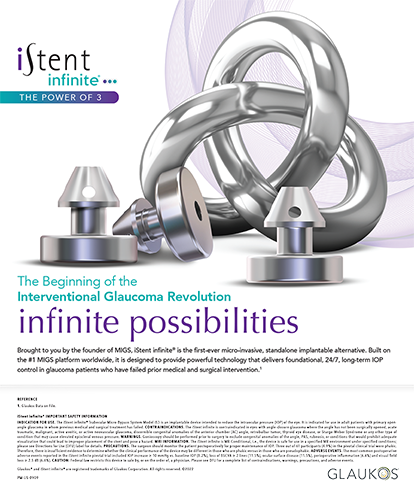Cover Stories | Jun 2005
Experience With the Rezoom IOL
Comparing this lens with the Array.
H. Burkhard Dick, MD
Presbyopic Newly approved by the FDA, the Rezoom hydrophobic acrylic multifocal IOL (Advanced Medical Optics, Inc., Santa Ana, CA) has a 6-mm optic featuring five zones optimized and proportioned to provide good visual function across a range of distances. After implanting more than 40 of these IOLs, I have found the lens to be an improvement on the Array multifocal IOL (Advanced Medical Optics, Inc.).
LENS DESIGN
The five concentric, refractive zones provide true multifocal vision: zones 1, 3, and 5 are distance dominant; zones 2 and 4 are near dominant; and an aspheric transition between zones provides balanced intermediate vision. The second optical zone provides a sufficiently large near add. The IOL's Balanced View Optics Technology provides expanded distance-dominant zones and light distribution for good vision under a broad range of lighting conditions. The Rezoom IOL works satisfactorily at intermediate distance and under dim lighting conditions, an especially important capability for computer work.
I prefer an optic edge design that provides an uninterrupted 360º barrier against lens epithelial cell migration and is designed to minimize edge glare.1,2 The Optiedge design (Advanced Medical Optics, Inc.), which has been incorporated into the Rezoom IOL, decreases the intensity of reflected images tremendously compared with square-edge designs.3
Surgeons already familiar with the Sensar three-piece monofocal IOL (Advanced Medical Optics, Inc.) should find the Rezoom lens easy to use, because the two IOLs' A-constants are the same and they unfold in the eye similarly. Additionally, the Unfolder Emerald injector system (Advanced Medical Optics, Inc.) allows the Rezoom to be implanted through a 2.7-mm incision. I have found that this IOL centers perfectly. In a rare case of capsular rupture with vitreous loss, the lens may be fixated in the sulcus.
Capsular fibrosis with this hydrophobic acrylic lens material was very low.1,4 Moreover, with a low rate of posterior capsular opacification, the near portion of the lens' optic is not obscured by fibrosis. As a result, patients' reading capability should last longer compared with the silicone optic of the Array lens.4 Rezoom patients' near visual acuity should remain stable for a long time.
STUDY RESULTS
I conducted a prospective, randomized, masked clinical trial to compare the Rezoom (n = 24) and the first-generation Array (n = 18) IOLs. Outcomes with the former proved superior in several regards.
The mean defocus acuity curves for both IOLs were similar; they demonstrated acceptable near vision and excellent intermediate vision, which is not achieved with current diffractive multifocal IOL designs. Patients who received the Rezoom lens reported that they saw comfortably without glasses at distance (100%), intermediate distance (95%), and near (71%). Sixty-seven percent of my Rezoom patients never wore glasses at 6 months postoperatively. All Rezoom patients reported driving easily, and they expressed great satisfaction with their depth and color perception, neither of which deteriorated during 6 months of follow-up.
Regarding distance-corrected near visual acuity, 83.3% of Rezoom patients saw 20/40 or better. The group's mean binocular distance UCVA was 20/20, and the mean binocular distance BCVA was 20/17. These patients' mean near UCVA at 40cm was 20/42, and their distance-corrected visual acuity at 40cm was 20/35. All Rezoom eyes had a binocular distance BCVA of 20/25 or better.
Compared to the Array IOL, the Rezoom IOL produced fewer photic phenomena. Specifically, the incidence of halos with the Rezoom was one-third that with the Array lens. The former was also associated with distinctly fewer incidences of starbursts. No Rezoom patient complained of severe halos, double vision, blurred near or far vision, or starbursts. Only one reported moderate starbursts for one eye.
CONCLUSION
Photic phenomena were less of a problem with the Rezoom IOL versus the first-generation multifocal Array lens. The latter is one of the few IOLs investigated thoroughly enough to provide practitioners with an excellent understanding of its functionality. I do not doubt that the Rezoom lens will be of benefit to my patients. n
H. Burkhard Dick, MD, is Clinical Professor and Head Physician for the Department of Ophthalmology, Johannes Gutenberg-University, Mainz, Germany. He states that he holds no financial interest in the products or companies mentioned herein. Professor Dick may be reached at +49 61 31175445; bdick@mail.uni-mainz.de.
1. Buehl W, Findl O, Menapace R, et al. Effect of an acrylic intraocular lens with a sharp posterior optic edge on posterior capsule opacification. J Cataract Refract Surg. 2002;28:1105-1111.
2. Ellis MF. Sharp-edged intraocular lens design as a cause of permanent glare. J Cataract Refract Surg. 2001;27:1061-1064.
3. Franchini A, Gallarti BZ, Vaccari E. Computerized analysis of the effects of intraocular lens edge design on the quality of vision in pseudophakic patients. J Cataract Refract Surg. 2003;29:342-347.
4. Sacu S, Menapace R, Buehl W, et al. Effect of intraocular lens optic edge design and material on fibrotic capsule opacification and capsulorhexis contraction. J Cataract Refract Surg. 2004;30:1875-1882.


